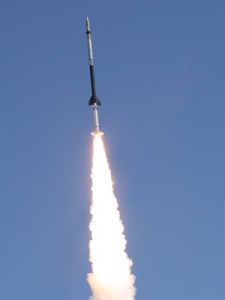
A LASP-built instrument launched aboard a sounding rocket on May 3 with the goal of providing calibration data for a twin instrument already in flight aboard NASA’s Solar Dynamics Observatory (SDO). The “rocket-based” Extreme ultraviolet Variability Experiment, or EVE, was launched from the Air Force’s White Sands Missile Range near Las Cruces, New Mex.
The solar observations made by the rocket instrument provided a well-calibrated solar spectrum, which will now be compared to observations taken by the EVE instrument aboard SDO at the same time. The spacecraft-based EVE will be corrected to match the spectrum provided by the rocket-based EVE.
Future rocket flights with the EVE instruments will allow LASP scientists to track long-term changes in the space-based EVE. Since the rocket instrument is recovered each time, and calibrated before each launch, scientists are able to use the rocket-based EVE as a benchmark for the science data coming from space.
EVE monitors the sun where it is most variable — in the extreme UV part of the spectrum — and measures the spectrum every 10 seconds. At these wavelengths, the brightness of the sun can rise and fall a hundredfold within seconds, heating and “puffing up” the Earth’s upper atmosphere, which absorbs the high-energy UV photons. EVE measures these changes with unprecedented time and spectral resolution. The instrument was designed and built, in part, by engineers, scientists and students at LASP.
Launched on Feb. 11, SDO is the most advanced spacecraft ever launched to study the sun and its dynamic behavior. The spacecraft will provide images with clarity ten times better than high definition television and more comprehensive science data faster than any solar observing spacecraft in history.
NASA, NOAA, and the Air Force will use EVE data to more precisely predict how each solar flare will change our ionosphere. With this information, scientists will be able to be proactive, instead of reactive, to the impact of these solar storms on our technology.



